Olympics Soccer showcases emerging football stars on a global stage. While the FIFA World Cup often dominates headlines, the 2024 Paris Olympics delivered a fresh, fast-paced format that thrilled fans and celebrated the unique blend of youth, talent, and national pride.
Over the years, the rules evolved dramatically—from amateur-only squads to today’s U-23 regulations for men and full-age eligibility for women. Notably, the Paris Games highlighted these changes, offering intense matchups, surprising results, and rising stars who seized the spotlight.
Moving forward, many wonder if Olympic Soccer could one day rival the global prestige of the World Cup.
⚽ Did You Know?
“For the first time ever, all Olympic football matches were streamed live with real-time stat overlays, allowing fans in the U.S. to follow every kick, pass, and goal.”

Introduction to Soccer Olympics
Soccer has been an Olympic staple since 1900, yet its rules, prestige, and global role have evolved in striking ways. Once a contest for amateur athletes, Olympic soccer transformed into a dynamic mix of youth, national pride, and fierce competition—especially evident during the 2024 Paris Olympics soccer tournament. Over the years, Olympic football has grown into a major platform for rising stars and future legends, even though it remains distinct from the more globally dominant FIFA World Cup.
In this deep dive, we’ll explore the entire journey of Olympic soccer, from its earliest days to its most recent Paris 2024 chapter. We’ll break down the unique Olympic football rules, explain how the tournament structure works, and revisit notable matches and medal-winning teams. Along the way, we’ll highlight star players from the U.S. and abroad, expose the controversies surrounding age restrictions and club conflicts, and discuss whether this tournament could ever rival its FIFA counterpart. Whether you’re a casual fan or a die-hard supporter, this article brings you everything you need to know about Olympic Soccer—past, present, and future.
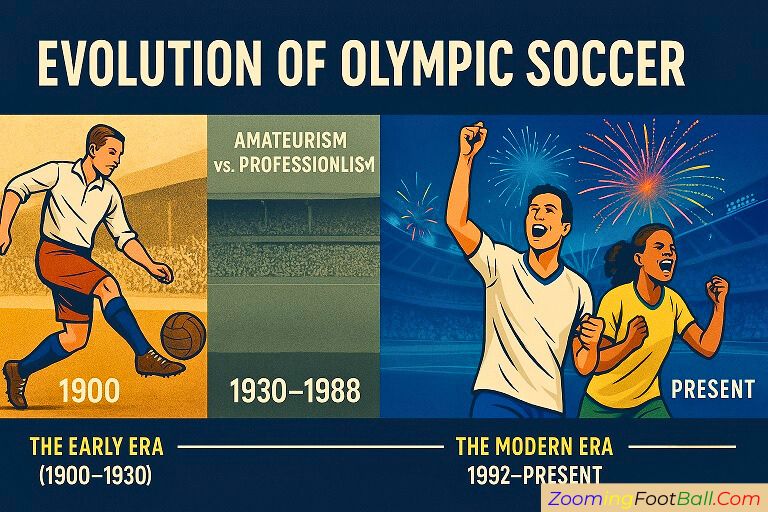
Evolution of Olympics Soccer: A Historical Timeline
The Olympic Soccer story reflects shifting power, evolving rules, and political tension. Starting in the early 1900s and advancing to today’s high-stakes matches, the sport mirrors global trends in society and football. Below is a shortened timeline, highlighting three major eras.
The Early Era (1900–1930)
Initially, Olympic Soccer appeared at the 1900 Paris Olympics as a mere exhibition. British teams, notably Great Britain, dominated early competitions with gold wins in 1908 and 1912. Meanwhile, Uruguay reshaped the game by clinching back-to-back golds in 1924 and 1928 with their slick passing and physical finesse. Consequently, Uruguay’s success set the stage for their 1930 FIFA World Cup victory and elevated Olympic football’s prominence.
Amateurism vs. Professionalism (1930–1988)
During this period, tension soared between FIFA and the International Olympic Committee (IOC). To protect the World Cup’s prestige, the Olympics limited participation to amateur players. Although this rule favored the Soviet bloc—including the USSR, East Germany, and Yugoslavia—which dominated the games, it also limited Western countries like the United States. Therefore, despite questions over its relevance, the tournament maintained a cherished place in sports history.
The Modern Era (1992–Present)
In 1992, Olympic soccer entered a new phase that still defines the sport today. FIFA and the IOC finally compromised: men’s teams would now use U-23 squads, allowing just three overage players per team. This rule preserved the Olympics’ youth-focused image while allowing some star power. Olympic football rules became clearer, more consistent, and more exciting.
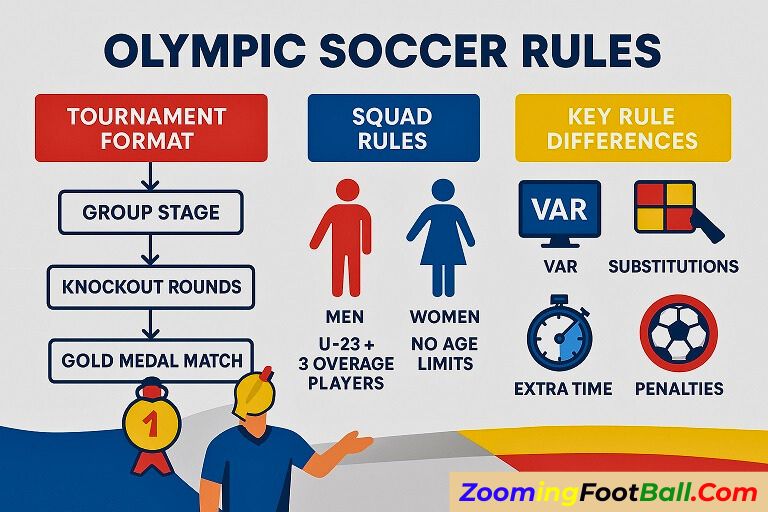
How Olympics Soccer Works in 2024
The 2024 Paris Olympic Soccer Tournament thrilled fans with a unique format that emphasized youth development and fair play. Unlike the FIFA World Cup, the Olympics modified its structure to spotlight emerging talent and deliver intense, unpredictable matches.
Tournament Format – Group Stage, Knockout Rounds, Gold Medal Match
The structure of the 2024 Paris Olympics soccer tournament followed a familiar yet high-stakes format. Both the men’s and women’s competitions featured 16 national teams, divided into four groups of four. During the group stage, each team played three matches in a round-robin setup. The top two teams from each group advanced to the knockout stage.
The knockout rounds were intense and fast-paced. Starting from the quarterfinals, each match had no room for error. If a match ended in a draw, it went into extra time and, if needed, penalties. The winners advanced to the semifinals, leading up to the final clash for Olympic gold. The third-place teams battled it out for the bronze medal.
Here’s a quick overview of the 2024 Olympic soccer format:
| Stage | Teams Involved | Match Outcome |
| Group Stage | 16 Teams | Round-robin (Top 2 qualify) |
| Quarterfinals | 8 Teams | Knockout |
| Semifinals | 4 Teams | Knockout |
| Bronze Medal Match | 2 Teams (Losers of Semis) | Knockout |
| Gold Medal Match | 2 Teams (Winners of Semis) | Final |
This structure kept fans on edge, especially during the dramatic extra-time thrillers that became the hallmark of the Paris Games.
Squad Rules – Balancing Youth and Experience
In the men’s tournament, each team fields U-23 players plus up to 3 overage players, thereby promoting youth while incorporating valuable experience. Conversely, the women’s competition lifts all age restrictions, allowing national teams to select their top players and adding even more star power.
Key Rule Differences – VAR, Substitutions, Extra Time, Penalties
While the basic gameplay followed FIFA’s guidelines, there were a few key differences in the Olympic football rules that set 2024 apart. First, the Video Assistant Referee (VAR) was used in full effect. From offside calls to red cards, VAR reviews played a crucial role in several controversial decisions during the tournament.
Teams were also allowed five substitutions, with an additional one permitted in extra time. This gave coaches flexibility, especially when managing fatigue or injuries in the knockout rounds.
If a match ended in a draw during the knockout stage, the game went into 30 minutes of extra time, followed by a penalty shootout if needed. Several of the 2024 matches—including a heart-stopping men’s semifinal—were decided by penalties, adding drama and intensity.
So while the rules echoed the World Cup in many ways, the Olympic soccer rules in 2024 added their own flavor, balancing tradition with modern innovation.
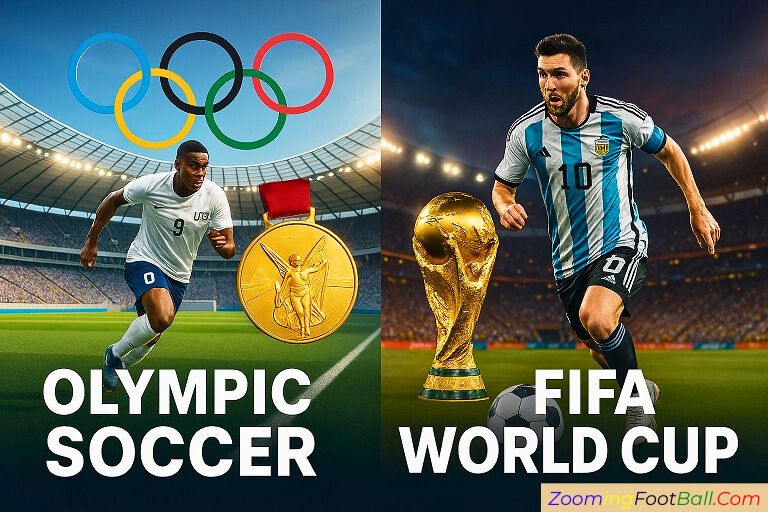
Olympics Soccer vs. FIFA World Cup: Key Differences
While both tournaments celebrate global football, Olympic soccer and the FIFA World Cup differ in many meaningful ways. Although both offer international glory, the World Cup holds a much higher prestige in the soccer world. That said, the Olympic Games have their own charm—especially for younger players and fans of underdog stories.
In 2024, fans once again noticed how these two events contrast in squad eligibility, tournament frequency, and media coverage. These distinctions explain why one remains a cultural phenomenon while the other is more of a developmental stage for emerging stars.
Why the World Cup Overshadows the Olympics – Player Eligibility, History, Media Coverage
First and foremost, player eligibility is a major factor. The FIFA World Cup allows countries to field their absolute best squads without any age restrictions. Every top player—from Messi to Mbappé—is available for selection, which makes each match elite-level competition. By contrast, Olympic soccer, especially in the men’s division, follows strict age rules (U-23 plus 3 overage players). This means many superstars don’t participate, leading to a slightly lower quality of play.
History also plays a crucial role. The World Cup, launched in 1930, has built decades of global tradition and is seen as the sport’s most prestigious trophy. Olympic soccer, on the other hand, has shifted in importance over the years. From amateur-only lineups to today’s hybrid system, it hasn’t carried the same weight as the World Cup for most of its history.

2024 Paris Olympics: Soccer Teams, Stars & Predictions
The 2024 Paris Olympics soccer tournament delivered on drama, dreams, and dazzling talent. Both the men’s and women’s competitions showcased fierce competition, with national pride at stake and young stars eager to shine on the world’s biggest multi-sport stage. The event brought unforgettable moments from major teams, while showcasing future legends.
Qualified Teams in Soccer Olympics – Men & Women
The men’s tournament featured 16 nations, each qualifying through their respective confederations. Hosts France automatically earned a spot and fielded a competitive side despite the U-23 rule. Other heavyweights like Argentina, Spain, and Brazil brought deep squads with a mix of youth and leadership. Surprise entrants like Egypt and New Zealand added unique energy to the tournament.
The women’s competition, without age restrictions, included the very best. The United States, always a dominant force in women’s soccer, entered as top contenders alongside Germany, Brazil, Canada, and Japan. European champions England also competed, hoping to convert continental success into Olympic gold.
The complete list of qualified teams is shown below:
| Tournament | Qualified Teams |
| Men’s | France, Argentina, Spain, Brazil, Egypt, Germany, Mexico, Japan, New Zealand… |
| Women’s | USA, Germany, Brazil, England, Canada, Japan, Sweden, Netherlands, Australia… |
Players to Watch – Pulisic (USA), Mbappé (France), Marta (Brazil)
The spotlight naturally fell on certain superstars—and most delivered. Christian Pulisic, the U.S. men’s captain, was one of the tournament’s most watched players. Though limited by the overage rule, his leadership helped inspire a youthful American squad.
Kylian Mbappé, who had publicly expressed interest in representing France at the Paris Olympics, eventually secured club permission and played in front of home fans. His presence alone electrified crowds and boosted viewership worldwide.
On the women’s side, Marta, the Brazilian legend, made her final Olympic appearance. Her performance, full of elegance and grit, became one of the most emotional storylines of the games. Other rising stars like Lauren James (England) and Trinity Rodman (USA) also turned heads with breakout performances.
Venues & Schedule – Stade de France, Marseille, Bordeaux
Matches were held across six iconic French cities, giving local fans a chance to experience Olympic soccer firsthand. The Stade de France in Paris hosted the gold medal matches and opening fixtures. It stood as the centerpiece of the tournament, packed with passionate crowds and high drama.
Other matches took place in historic and modern stadiums across Marseille, Lyon, Bordeaux, Nice, and Nantes. This distribution not only helped spread Olympic fever across the country but also offered players a world-class experience in front of roaring fans.
The tournament ran from July 24 to August 10, 2024, with a tight schedule of group stages, quarterfinals, semifinals, and the final. The final matchday saw France host an electric gold medal match that capped off a historic run for both men’s and women’s soccer.
The 2024 Paris Olympics soccer competition left behind thrilling memories, emerging stars, and emotional farewells. As fans now look forward to 2028 in Los Angeles, the legacy of Paris 2024 remains strong.
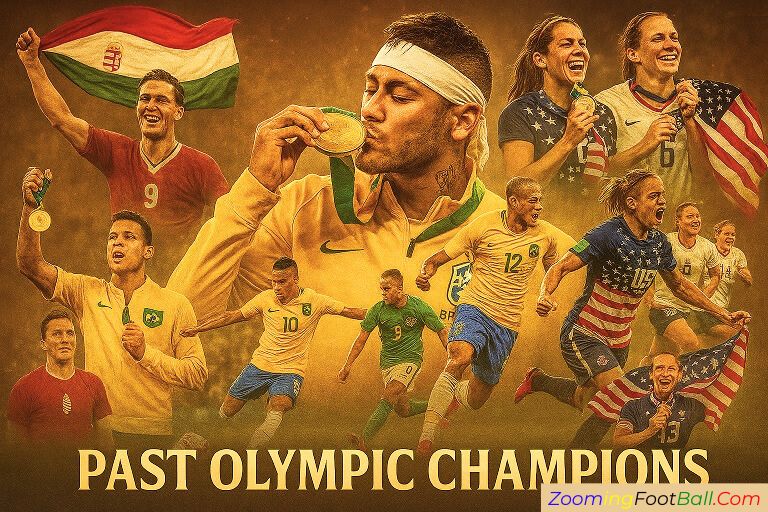
Past Olympics Soccer Champions & Memorable Moments
The history of Olympic Soccer is filled with unforgettable victories and emotional highlights that have shaped the tournament’s global significance. From early European domination to South American flair and fierce women’s rivalries, these moments reflect the evolution of Olympic football rules and the passion it continues to ignite worldwide.
Over the decades, certain nations and eras have stood out—Hungary’s golden run, Brazil’s long-awaited gold, and the USA’s dominance in women’s soccer. These stories didn’t just shape Olympic history; they influenced football culture itself.
Men’s Soccer Medalists – Hungary (1952–1968), Argentina (2004–2008), Brazil (2016)
During the early decades of Olympic soccer, Hungary emerged as the undisputed king. From 1952 to 1968, Hungary won three gold medals and one silver, led by legends like Ferenc Puskás. Their tactical brilliance and technical superiority became the gold standard for Olympic football during the Cold War era, dominating the field through superior ball control and formation strategies.
After Hungary’s fall from the Olympic summit, other powerhouses rose. Argentina, led by stars like Carlos Tévez and Lionel Messi, claimed back-to-back golds in 2004 and 2008. Their squads blended elite youth talent with experienced players, highlighting Argentina’s deep football pipeline.
Then, in 2016, the long wait finally ended for Brazil. After losing heartbreakingly to Mexico in the 2012 final, Brazil won their first-ever Olympic gold in men’s soccer on home soil in Rio de Janeiro. With Neymar scoring the decisive penalty in a shootout against Germany, the moment brought tears of joy and national pride, sealing a gap in the nation’s otherwise legendary football resume.
| Year | Gold Medalist | Silver | Bronze |
| 1952 | Hungary | Yugoslavia | Sweden |
| 1964 | Hungary | Czechoslovakia | Germany |
| 2004 | Argentina | Paraguay | Italy |
| 2008 | Argentina | Nigeria | Brazil |
| 2016 | Brazil | Germany | Nigeria |
These victories weren’t just medals—they were symbolic milestones for entire footballing generations.
Women’s Soccer Dominance in Olympics– USA’s 4 Golds, Norway/Germany rivalry
The inclusion of women’s soccer in the Olympics in 1996 marked a new era—and from the very start, the United States asserted itself as the global powerhouse. They won the inaugural gold and followed up with wins in 2004, 2008, and 2012, showing consistency, leadership, and tactical brilliance. Stars like Mia Hamm, Abby Wambach, and Carli Lloyd inspired millions through both their dominance and sportsmanship.
Germany and Norway stood out as the USA’s fiercest rivals. Norway stunned the world in 2000, defeating the U.S. in a dramatic final that ended in extra time. Germany finally claimed gold in 2016, showing a perfect blend of youth development and veteran precision. Their Olympic journeys added depth to an already fierce rivalry among top women’s nations.
| Year | Gold Medalist | Silver | Bronze |
| 1996 | USA | China | Norway |
| 2000 | Norway | USA | Germany |
| 2004 | USA | Brazil | Germany |
| 2008 | USA | Brazil | Germany |
| 2012 | USA | Japan | Canada |
| 2016 | Germany | Sweden | Canada |
Each tournament created memorable moments—Carli Lloyd’s midfield goal in 2012, Birgit Prinz’s clutch plays, and Marta’s magic. These legacies still echo in women’s football today.
Olympic soccer history is more than just medal counts—it’s the story of nations rising, legends born, and the beautiful game played under the Olympic flame. With each passing edition, the tournament cements its role not just as a developmental stage, but as a global spectacle rich in tradition and emotion.
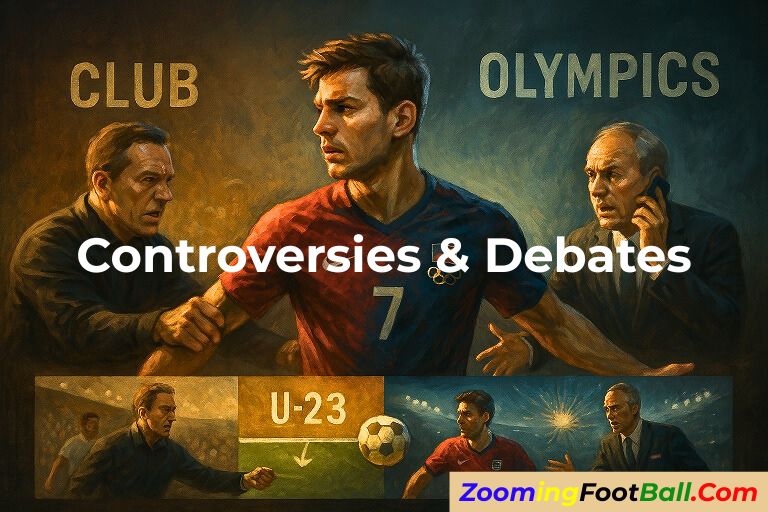
Controversies & Debates in Soccer Olympics
The Olympic Soccer event excites fans yet ignites controversies that shape public debate and challenge established norms. Notably, the 2024 Paris Olympics renewed discussions about fairness and future policy. Below is a concise breakdown of the key debates.
Age Limit Criticisms – Does it weaken competition?
Since 1992, the men’s tournament enforces an age restriction where players must be under 23, with three overage players allowed. Although this rule aims to develop young talent and distinguish the event from the FIFA World Cup, critics argue it undermines competitive integrity. Consequently, fans often miss top players, as stars like Erling Haaland and Harry Kane remain ineligible. Meanwhile, the women’s tournament allows full senior squads, prompting calls for reform and greater parity. Ultimately, supporters argue that the Olympic stage deserves the best talent regardless of age, yet the policy stayed unchanged in 2024.
Club vs. Country Conflicts – Clubs blocking players (e.g., Premier League)
In Europe, national teams and professional clubs clash over player availability since the Olympics fall outside the FIFA international match calendar. As a result, clubs often refuse to release key players from leagues such as the Premier League, La Liga, and Serie A. For instance, doubts about Kylian Mbappé’s participation highlighted the ongoing conflict between club duties and national pride. Consequently, some teams play at a disadvantage, while others boast enhanced talent. National federations and clubs remain divided, with federations frustrated by last-minute withdrawals and clubs prioritizing player protection. Ultimately, this tension calls for stronger collaboration between FIFA and the IOC or innovative scheduling solutions to balance interests.
These debates over age limits and club-player conflicts continue to influence Olympic Soccer and its global reputation. As the sport evolves, stakeholders actively seek solutions that enhance competitive fairness, protect players, and boost global appeal.
The Future of Soccer Olympics
Olympic Soccer continues to evolve, and its future sparks significant interest amid growing competition from events such as the FIFA World Cup and expanding professional leagues. Consequently, the tournament must adapt to stay relevant. Several potential reforms aim to attract more talent, fans, and media attention.
Reforms for Growth: Soccer Olypics
Firstly, experts consider expanding the age limits in the men’s tournament. Revising the U-23 rule to allow more senior players could immediately boost competition and enhance audience appeal. Additionally, increasing collaboration between FIFA and the International Olympic Committee (IOC) could simplify scheduling conflicts, making it easier for top players to participate. Moreover, integrating name, image, and likeness (NIL) deals for college players could amplify excitement by providing rising stars with a platform to build their brands. You may also like this: Cristiano Soccer – The Ultimate Biography & Legacy
FAQs: Soccer Olympics
When did soccer become an Olympic sport?
Soccer became an Olympic sport in 1900 for men and in 1996 for women.
Why didn’t top European stars play in the Olympics?
Top European stars didn’t play in the Olympics due to age limits (the U-23 rule for men) and club priorities, as clubs didn’t want to release players during crucial parts of the season.
Did Mbappé play in the 2024 Olympics?
Whether Kylian Mbappé played in the 2024 Paris Olympics depended on approval from FIFA and his club, Paris Saint-Germain. It was uncertain at the time.
Conclusion Soccer Olympics
To wrap up, Olympic soccer has come a long way since its start in 1900, evolving with new rules and more global participation. The 2024 Paris Olympics featured top teams like France, Argentina, and the USA competing for gold. Age limits and player availability created plenty of drama during the tournament.
Looking ahead, Olympic soccer may grow even more with potential rule changes and stronger FIFA collaboration. Could it rival the World Cup? Only time will tell.
Who was your favorite for gold? Comment below and share your thoughts!

Oliver Brown, a seasoned football blogger with a knack for insightful commentary, brings decades of passion and expertise to Zooming Football. Known for his sharp analysis and engaging storytelling, Oliver delves deep into the game’s nuances, offering readers a unique perspective on football’s most captivating stories and strategies.







